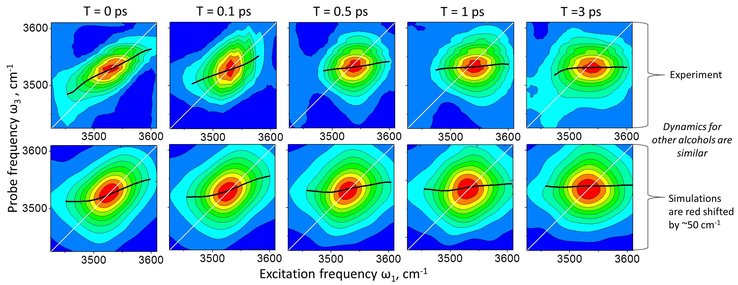Pchenitchnikov Group
The group uses ultrafast laser-spectroscopy to study the dynamics of various materials.
Two-dimensional spectroscopy of hydrogen bond dynamics
In the past decade, water dynamics have been put in the research spotlight thanks to tremendous advances in 2-dimensional infra-red spectroscopy and combined molecular dynamics - quantum chemistry calculations. In particular, the important process of hydrogen-bond dynamics has been studied and fascinating spectroscopic aspects of inter- and intramolecular vibrational couplings and vibrational exciton formation have been identified.
Alcohols present another example of hydrogen-bond liquids that differ from water in many important aspects. First, in alcohols the number of donated hydrogen-bonds per molecule is different from the number of accepting hydrogen-bonds. This disrupts the 3D hydrogen-bond network so characteristic for water. Second, alcohol molecules being amphiphilic contain both hydrophobic and hydrophilic parts, which add complexity to the hydrogen-bond dynamics. Third, the size of alcohol molecules can be easily varied, e.g. by going from primary to secundary or tertiary alcohols.

Ultrafast charge dynamics of novel star-shaped molecules for organic photovoltaics
Solution-processable bulk-heterojunction organic solar cells based on conjugated small molecules are a promising alternative to conventional polymer organic solar cells. Small molecules have a number of attractive advantages over conjugated polymers like excellent batch-to-batch reproducibility, well-defined molecular structure, etc. Although small molecule based solar cells are the emerging branch of organic solar cells, they have already reached the outstanding efficiency of ~10%.
We studied a series of novel star-shaped small molecules with variable lengths of the thiophene conjugated arm. Photovoltaic blends based on these small molecules as a doner and PC70BM as an acceptor were studied by visible-pump infrared-probe photoinduced absorption spectroscopy to interrogate ultrafast charge separation and recombination. We identified charge separation and recombination pathways and proposed means to improve the organic solar cell efficiency.
